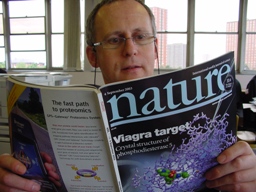
Geoscientist 18.9 September 2008
Ted Nield writes from the Euro Science Open Forum (ESOF) in Barcelona about Discipline Hopping Grants…
Many years ago I found myself trailing around a university (that perhaps should remain nameless) behind the late Sir William Mitchell FRS (1925-2002), renowned physicist, Chairman of the Science and Engineering Research Council (SERC), and a huge champion of pan-European and multidisciplinary cooperation in science.
SERC had wanted me to observe a “site visit” so that I could write about it for their in-house mag; but my comfy status as silent witness stood in stark contrast to that of the researchers. We went from lab to lab, appearing before one team after another, each stumbling through their prepared speeches like would-be entrepreneurs in Dragon’s Den. Bill smiled benignly, and was a lot less scary than Deborah Meaden; but he clearly inspired dread, and seemed reluctant to break the spell. He asked the questions, cocking a sceptical eye during the stammered answers.
We climbed an exterior metal staircase to an engineering lab, where SERC had been funding research into fluidised bed combustion. The researcher, almost obscured by his contraption, listed the problems they had encountered - problems which, he seemed to suggest, would soon form the subject of further research proposals. He explained how the efficiency of fluidised beds depended on efficient mixing; but achieving this was hard. Contrary to expectations, the larger coals settled at the top, forming a clinker crust. Below, progressively finer grains collected, clogging the nozzles. They had no idea why. More research was (as ever) clearly needed.
To my horror, my mouth was suddenly open. “Isn’t this just reverse grading?” I piped. Bill’s gimlet eye now rested on me, brows lifted. “Er – I mean it’s a common phenomenon in natural débris flows...” Bill’s eyebrows reached his hairline. Nobody spoke. “I can’t explain the physics” I blundered on, filling the silence; “but it’s quite simple. The fine stuff falls between the big stuff as the flow matures, forcing big stuff to the top. It’s why the plastic toy comes to the top of your cornflakes. The conditions are the same in a fluidised bed… I’d have thought…”
Bill’s eyebrows were by this time well over the horizon; but now he was looking at the gaping engineers, who were probably wishing (as was I) that they had had the foresight to rig up a trapdoor where I was standing. “Well…” said Bill. “Talk to a sedimentologist before you ask us for any more money!”. And cackling gently, he led us to our next appointment.
If there is a moral to this, apart from to keep your trap shut, it could be that Earth science is more multidisciplinary than most. Our history is peppered with examples of new approaches and techniques that have revolutionised our subject. Other disciplines are less lucky. To help them out, the Medical Research Council (MRC) and the Engineering and Physical Research Council (EPSRC) have run, for the last eight years, a discipline-hopping scheme that transplants researchers out of their comfort zone. And in case this sounds a little distant from geology, NERC will also contribute towards any proposals that fall within its remit.
Which is a great opportunity for an environmental geochemist, or other medical geologist, to bring their special insight to the attention of epidemiologists, to take one possible example...
The scheme closes to applications on November 12. Visit
http://www.mrc.ac.uk/ApplyingforaGrant/AvailableGrants/DisciplineHoppingGrant/index.htm
to find out more.
Bill Mitchell would have approved.